Smoked Corned Beef
This post may contain affiliate links. Please read my disclosure policy.
Smoked corned beef is tender, juicy, and will melt in your mouth — just the way you like it! Made with a homemade brine and dry rub, it’s smoked and spritzed with apple juice. The results are out of this world tasty!

I’ve become pretty obsessed with my smoker ever since I got it. I use a Traeger and can’t recommend it enough. These smoked meatballs with BBQ sauce and smoked salmon are just a few of my favorite creations.
I’ve already shared recipes like this guide on how to make corned beef and my famous corned beef casserole. Today I’m putting a twist on the classic recipe. Introducing: smoked corned beef. I think you’re going to love this unique take on this comfort food meal just as much as I do!

How to Desalinize a Brisket
If you purchase a corned beef brisket in the store (or if you learned how to make corned beef here), you should let it soak in cold water for 6 hours to flush the excess salt out of the meat before smoking. I change the water every 2 hours.
If you purchased a beef brisket that has not been corned, follow the brine instructions in this recipe for the 1 day brine.

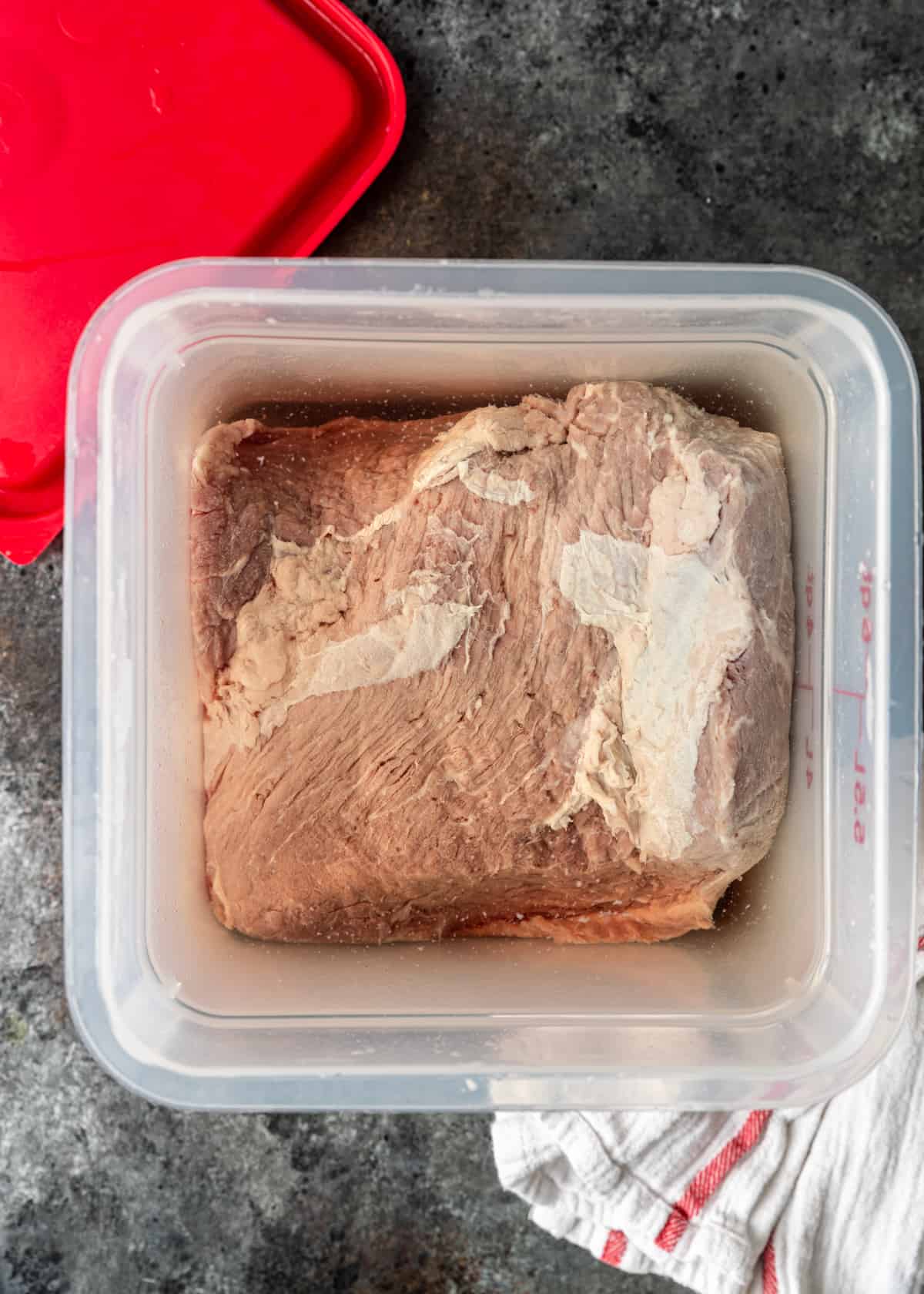
INGREDIENT NOTES AND SUBSTITUTIONS
- Beef Brisket – Make sure to opt for high-quality beef brisket for the best results.
- Water – The base of your homemade brine.
- Kosher Salt – You’ll need to use two types of salt for this smoked corn beef recipe, one of which is classic kosher salt.
- Brown Sugar – To add a touch of sweetness to your brine. It will also enhance the natural flavors of the beef. You’ll also use it in the dry rub.
- Pickling Spice Blend – Also for the brine. I swear by my homemade version!
- Pink Curing Salt – It’s essential that you use pink curing salt (not to be confused with pink Himalayan salt) in your brine. It’s the key to “corning” your smoked corned beef! Concerned with using it, I give an option in the recipe card Notes below!
- Garlic – To be used in the brine.
- Ground Black Pepper – A touch of spice that features a bit of smokiness as well. Use it in the dry rub.
- Colman’s Dry Mustard – Another flavor enhancer for your rub.
- Paprika – To add a pop of color and subtle spice to the mix.
- Onion & Garlic Powder – My two favorite ground spices, they add so much flavor to whatever you pair them with.
- Chipotle Powder – For even more subtle heat for the dry rub.
- Apple Juice – Use apple juice to keep your beef juicy as it smokes.

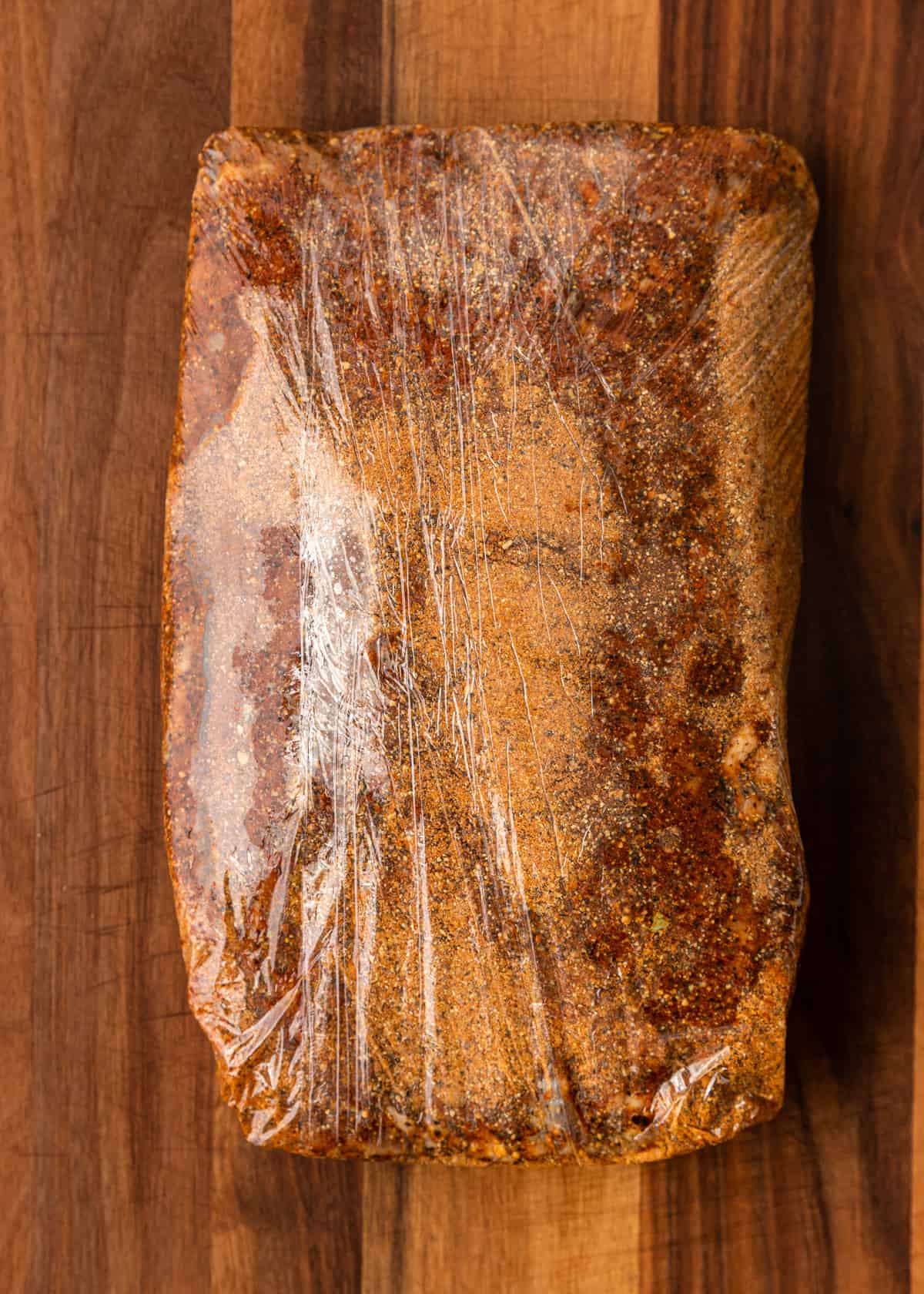

HOW TO MAKE SMOKED CORNED BEEF
1. Prep The Meat. If you purchased an already corned beef brisket, allow it to soak in cold water for 6 hours to flush out any excess salt before smoking. Change the water every 2 hours, then move on to Step 4. If you bought beef brisket that hasn’t been corned (another term for brined), go to Step 2.
2. Create The Brine. Add the brine ingredients to a Dutch oven or large stock pot and stir. Bring the mixture to a boil. Lower the heat to simmer and cook for 5 minutes, or until the salt and sugar have dissolved. Turn off the heat and allow it to cool.
3. Soak The Meat. Place the beef brisket into a large container or sealable plastic bag. Pour in the cooled brine over and cover or seal (remove any excess air if using a bag). Store it in the fridge for 24 hours, being sure to flip the bag or container after 12 hours.


4. Make & Apply Dry Rub. Combine the brown sugar, black pepper, dry mustard, paprika, onion powder, garlic powder, and chipotle powder in a bowl and set aside. Trim any excess fat off of the brisket, leaving a ¼-inch of fat on the fat cap side. Spray the brisket with apple juice, then apply to rub evenly. Wrap the beef in plastic wrap (place on a tray to catch any drips) and refrigerate overnight.
5. Smoke The Brisket. Let the brisket come to room temperature before smoking. Insert your meat thermometer and smoke at 225°F, or until the internal temperature reaches 165°F. Increase the temperature to 275°F and smoke until the internal temp reaches 200°F. Spray with apple juice every 90 minutes.
6. Rest & serve. Remove your smoked corned beef from the smoker and wrap it in unwaxed butcher paper. Place it in a small cooler to rest for 1-2 hours before slicing and serving.

How Long Does Corned Beef Take To Smoke?
It depends on the size. The first round of smoking will take about 4.5 hours for a 3-pound cut of beef brisket. The second round should take about 4.25 hours. You’ll have to adjust the time for larger cuts — the important thing is that the internal temp reaches the temperatures indicated on the recipe card below.

Is Pastrami Just Smoked Corned Beef?
The main difference between pastrami and corned beef is the way they are cooked and cut. Pastrami is made by smoking and steaming beef brisket. Smoked corned beef is made by brining the brisket and then smoking it. The difference in taste is subtle, but it’s there! Check out my recipe on How to Make Pastrami here.
Why Is My Smoked Corned Beef Tough?
You likely smoked it at a too-high temperature. Follow the instructions on the recipe card closely for the best results — when you do, you’ll end up with perfectly soft and tender smoked corned beef!
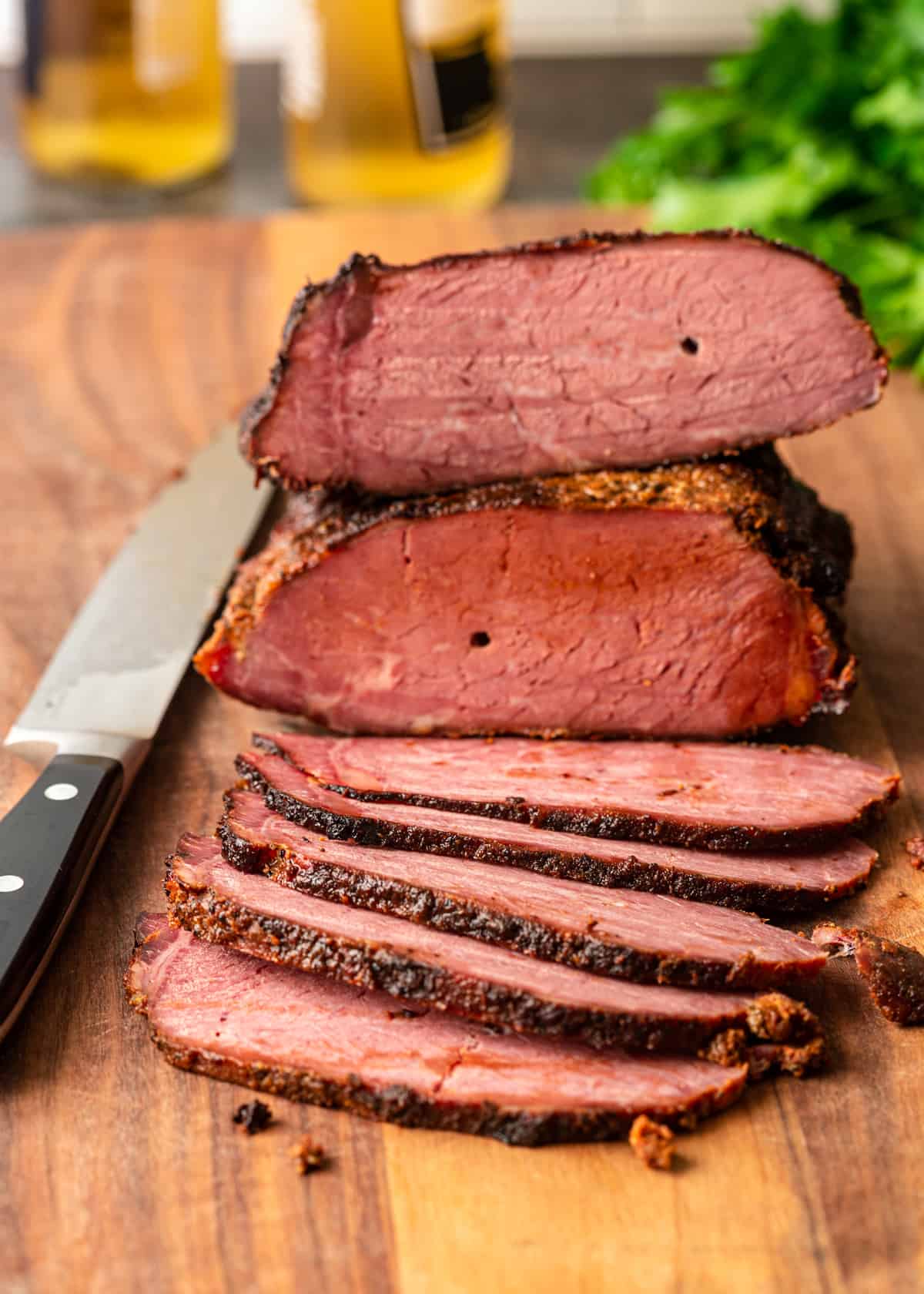
Subscribe to my Newsletter, follow me on Facebook, Pinterest, Instagram and YouTube for all my latest recipes and videos.

Smoked Corned Beef
Ingredients
- 3 lb beef brisket flat
Brine
- 2 quarts water (8 cups)
- 250 g kosher salt (See Note 1)
- 1/2 cup packed brown sugar
- 1/3 cup pickling spice blend
- 2 tsp pink curing salt (See Note 2, 3)
- 4 cloves garlic minced
Rub
- 1/4 cup brown sugar
- 1 tbsp ground black pepper
- 1 tbsp Colman’s Dry Mustard
- 2 tbsp paprika
- 2 tsp onion powder
- 2 tsp garlic powder
- 1 tsp chipotle powder
Smoking
- 8 ounces apple juice
Instructions
- If you purchased a beef brisket that has not been corned (brined), go to Step 3 below.
- If you purchased a corned beef brisket from the store you should let it soak in cold water for 6 hours to flush the excess salt out of the meat before smoking. Change the water every 2 hours. This step is essential, then proceed to Step 5.
- In a Dutch oven or large stock pot combine brine ingredients and stir. Bring to a boil, lower to simmer and cook 5 minutes (until salt and sugar have dissolved). Turn off heat and cool.
- In a large container or large sealable plastic bag place the beef brisket. Pour cooled brining liquid over and cover or seal (remove excess air in bag). Store in a refrigerator for for 24 hours. Flip the bag after 12 hours.
- Combine the rub ingredients, set aside. Trim any excess fat off of the brisket, leave a ¼" of fat on the fat cap side of the brisket. Spritz the brisket with apple juice, and apply the rub all over.
- Wrap the dry rubbed brisket in plastic wrap, place on a tray to catch any drips and refrigerate over night.
- Bring the brisket to room temperature before smoking (1 hour is fine).
- Insert your meat thermometer. Smoke the brisket (Super Smoke if on a Traeger) at 225°F until internal temperature reaches 165°F (about 4.5 hours for 3 lb, adjust time for larger cuts), then turn temp to 275°F and smoke until the internal temperature of the brisket reaches 200°F (about 4.25 hours for 3 lb, adjust time for larger cuts). Spritz the brisket every 90 minutes with apple juice during this process.
- Remove from smoker and wrap in (unwaxed) butcher paper to secure. Place in a small cooler to rest for 1-2 hours before slicing thin ACROSS the grain.
Notes
- Kosher salt is what I use and what I used to use from when working in the food industry, namely for its coarse, uniform, easy-to-pinch granules. It’s most often used in restaurant kitchens and catering. Kosher salt has much lighter, flakier crystals than table salt, but if you allow the salt to dissolve in the food, there really isn’t any difference compared to regular table salt. However, kosher salt is less likely to contain additives like anti-caking agents and iodine. Per Epicurious: It’s industrially produced by boiling off brine that’s pumped in and back out of a salt deposit. It is not kosher-certified; the name refers to how the salt crystals draw out moisture in the meat koshering process.
- A key ingredient in the “corning” process is using pink curing salt. I’m not talking Himalayan pink salt either! Pink curing salt is made using sodium nitrite that prevents food from going bad and spoiling while it’s being stored for a time. It’s also known as Prague powder #1, which is a combination of 6.25% sodium nitrite and 93.75% salt (sodium chloride) and usually some anti caking agents as well as pink dye. It’s also known as Pink curing salt is made using sodium nitrite that prevents food from going bad and spoiling while it’s being stored for a time. It’s also known as DQ Curing Salt #1, and is available online or at your local specialty market or butcher shop. Curing salt is dyed that pink color so it’s not mistaken for everyday white table salt. If you don’t have it, you can still make corned beef, but it is necessary for that vibrant pink color we associate with corned beef. If you don’t have or don’t want to use curing salt containing sodium nitrite, you can brine meats without it. “Without curing salt that contains sodium nitrite, the color of the cured meat will be gray rather than pink and the flavor is less sweet with a more pronounced “pickle” flavor.” Source: Home Preserving Bible site.
- If you prefer, there is a product made by Morton called Tender Quick. Tender Quick is a fast-cure mix so you can cure meats, poultry or game. It gives meats a tasty, cured flavor and that characteristic pink color. Simply omit the kosher salt and pink curing salt from my Brine recipe above and use 250g or 1 cup of Tender Quick in lieu of those two. Mix with remaining brine ingredients and follow the recipe. Morton Tender Quick mix contains salt, the main preserving agent; sugar, both sodium nitrate and sodium nitrite, curing agents that also contribute to development of color and flavor; and propylene glycol to keep the mixture uniform.
Nutrition
The information shown is an estimate provided by an online nutrition calculator. It should not be considered a substitute for a professional nutritionist’s advice.


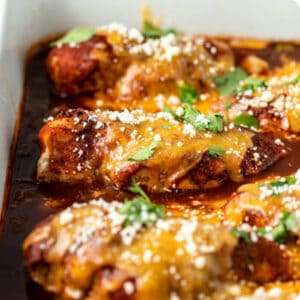
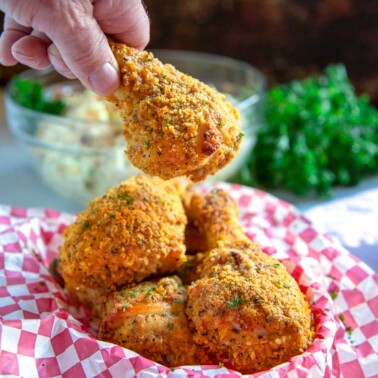
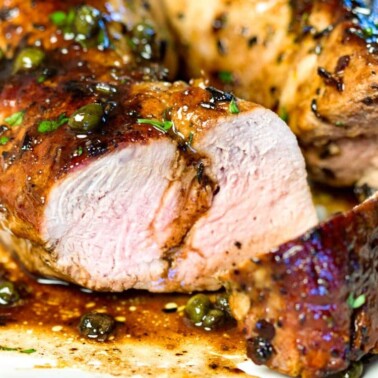

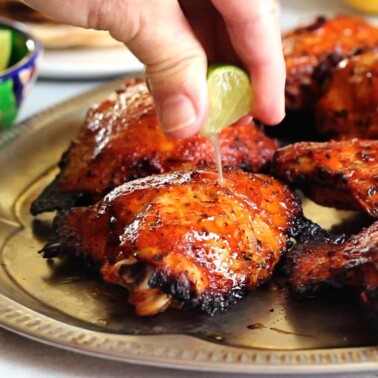












we are trying this recipe this weekend, can you tell me what type of chips you use to smoke with, any certain flavor you recommend with this recipe.
I typically get the walnut and cherry blend from Traeger. I would not use Hickory.
Question- I was going to follow your brine instructions for the 10 day brining process- however, I would like to smoke the brisket… Should I not brine for 10 days if it is being smoked? This recipe says 24 hrs.
Follow the directions here as written for the Smoked Corned Beef. The 24-hour brine and then subsequent dry rub and smoke do all the work here.
Very nice. I will have to try this as soon as I can dig my smoker out of the snow…
Luckily I have mine under a covered porch alongside the propane grill, I’d die without grilling or smoking once or twice a week Mitch. Hang in there!